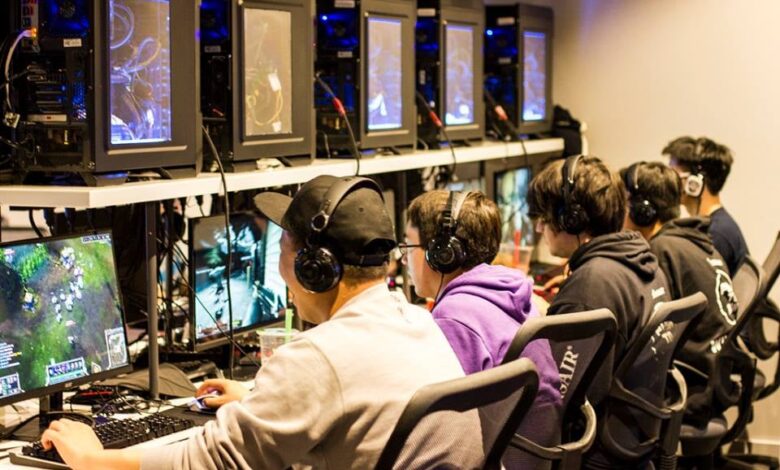The Social Gaming Values Connection and Entertainment

The world of video games has evolved far beyond a solitary hobby. Today, gaming is a powerful social platform, a digital hub where people connect, collaborate, and build communities that span the globe. The social gaming experience is no longer a secondary feature; it’s a fundamental part of the industry, driven by a new generation of players who value connection as much as competition. This article will take a deep dive into the core concepts of social gaming, exploring the pivotal role of technology, the new forms of community, the challenges that still need to be addressed, and the profound impact this will have on the future of entertainment and human connection.
The New Digital Hub

The rise of the internet has fundamentally changed how we play. The social aspect of gaming, which was once limited to a living room, is now a global phenomenon.
A. The Power of Cross-Platform Play
The days of being locked into a single gaming ecosystem are over. Cross-platform play is a game-changer, allowing players on a PC, a console, and a smartphone to all play together in the same game world. This has created a new level of social connectivity, as a player can now connect with their friends and family regardless of the device they own. This has a number of powerful implications:
- A Larger Community: Cross-platform play has created a larger, more diverse community for every game. A new player no longer has to worry about whether their friends are on the same console; they can simply jump in and play together.
- Seamless Social Interaction: The ability for players on different devices and platforms to communicate and collaborate has created a new level of seamless social interaction. This has made it easier for a player to join a game, to find a team, and to build a lasting friendship.
- A Unified Gaming Experience: Cross-platform play is a clear signal that the gaming industry is moving towards a more unified and accessible experience. The focus is no longer on a single piece of hardware; it is on the game itself and the community that surrounds it.
B. The Rise of the Gaming Community
The gaming community is no longer just a collection of individuals who play the same game. It’s a complex and vibrant ecosystem with its own culture, its own language, and its own rules. The new era of social gaming is about a new kind of community, with a focus on a shared, collaborative, and inclusive experience.
- Discord and In-Game Chat: Platforms like Discord and the in-game chat feature are the new social hubs for gamers. They provide a space for a team to communicate, to plan their strategy, and to celebrate a victory together.
- The Power of a Shared Experience: A new era of social gaming is defined by a shared, collaborative experience. Games with a cooperative goal or a focus on teamwork are a powerful tool for strengthening bonds and fostering a sense of community.
- A New Kind of Friendship: For millions of people, online games are a place where they have found a new kind of friendship. The bonds that are formed over a shared mission or a late-night gaming session are as real and as lasting as the ones that are formed in a physical setting.
The New Business Model
The business model for social gaming has also undergone a radical transformation. The traditional model of a one-time purchase is being replaced by a more flexible, accessible, and social one.
A. Free-to-Play and Micro-Transactions
The free-to-play model is the cornerstone of the social gaming ecosystem. A player can download and play a game for free, and the developer monetizes the game through in-game purchases and a subscription-based model. This model has several advantages:
- Lower Barrier to Entry: The free-to-play model eliminates the financial barrier to entry, allowing anyone with a smartphone or a computer to play a high-quality game. This has been a massive driver of growth, bringing gaming to a global audience that was once left out of the conversation.
- A Stable Revenue Stream: The free-to-play model provides a stable and predictable revenue stream for developers, which allows them to take on more creative and innovative projects.
- A Focus on Engagement: The model is a new and more effective way for a developer to monetize a game. The focus is on creating a game that is so engaging and so rewarding that a player will want to continue playing it for a long time.
B. The Power of a Shared Digital World
The new era of social gaming is defined by a shared, persistent digital world. These worlds are a new kind of social platform, a place where a player can build a home, a business, or a community. The games are not just about a single mission; they are about a shared, immersive experience that is a reflection of the community that surrounds it.
- The Metaverse: The metaverse, once a futuristic concept, is now a tangible space where people can socialize, work, and play in a shared virtual world. Games like Roblox and Fortnite are perfect examples of this, as they are not just games but social hubs with a massive, user-driven community.
- User-Generated Content: The new era of social gaming is also a new era of user-generated content (UGC). Players are no longer just consumers; they are co-creators. They can create their own levels, their own characters, and their own narratives, and then share them with a global audience. This is a powerful shift that is turning a player from a passive consumer into an active co-creator.
- The New Business Model: The business model of a social game is a new one. The focus is on a game as a service, with a continuous stream of new content, new events, and new social features. This model is a powerful way to build a loyal and engaged community.
The Road Ahead

While the future of social gaming is bright, there are significant challenges that must be addressed to ensure that this revolution is inclusive and sustainable.
A. The Challenge of Toxicity
The anonymous nature of online gaming can lead to a toxic and hostile environment. The new era of social gaming must address this challenge with a new focus on community management and a new set of rules for social interaction.
- AI-Powered Moderation: AI-powered tools can be used to moderate a game’s community, identifying and removing toxic players and creating a more positive and inclusive environment for everyone.
- Community Management: A professional community manager is now a crucial part of a game’s development team. Their role is to build a positive and welcoming community, to listen to the feedback of the players, and to ensure that the community is a safe and enjoyable place for everyone.
B. The Digital Divide
The full benefits of social gaming are dependent on a player’s access to a high-speed internet connection and a gaming console or a powerful computer. This creates a new digital divide, where individuals in regions with limited infrastructure are left behind. Closing this gap will require a massive investment from governments and private companies.
C. The Ethical Challenge of Monetization
The monetization of a social game, particularly a free-to-play game, can be a major concern. The use of in-game purchases, loot boxes, and other monetization models can be a major concern for parents. The industry will need to find a new and more ethical way to monetize social games, with a new focus on a fair and transparent system.
Conclusion
The social gaming experience is no longer a a simple feature of a game. It is a powerful and transformative force that is fundamentally reshaping our relationship with entertainment and with each other. What was once a simple form of escapism has evolved into a powerful tool for bringing a community together, strengthening bonds, and creating a new kind of shared, joyful experience. The focus on cross-platform play, a new kind of community, and a new business model is a clear signal that the future of gaming is about more than just a single player. It is about a shared, inclusive, and joyous experience that can be enjoyed by everyone, regardless of age or skill level.
However, as we embrace this new era, we must also confront the significant challenges that lie ahead. The challenge of toxicity, the need for a more ethical and transparent monetization model, and the digital divide are all hurdles that must be addressed proactively. The future of social gaming is a journey that will be defined not just by its technological prowess but by its ability to create a world that is more connected, more human-centric, and more conducive to a person’s overall well-being. The social gaming revolution is here, and it promises to build a future where our digital lives are as healthy and as happy as our real ones.

